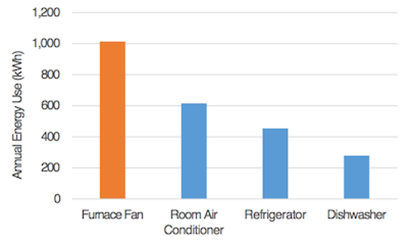 Notes: Based on 750 annual operating hours for room air conditioners; 215 cycles per year for dishwashers. Sources: DOE NOPR Technical Support Document for furnace fan energy use; AHAM Trends in Energy Efficiency 2012 for room air conditioner, refrigerator, and dishwasher energy use. |
Big energy savings can be achieved by switching out the motor used to drive a furnace fan. Typical furnace fans use permanent split capacitor motors, but brushless permanent magnet motors, which can be used to meet the new performance standards, are much more efficient and are available today. The new standards will save an average consumer about $340 to $500 over the life of a furnace fan. On a national level, it is estimated that the new standards will reduce electricity consumption by about 500 billion kilowatt-hours over thirty years of sales, an amount equal to the annual electricity use of about 47 million U.S. households, and will save consumers $29 billion. The standards will take effect in 2019.
Besides saving consumers money on their energy bills, the new standards for furnace fans can also improve comfort in two ways. First, furnace fans using current motors are often unable to provide sufficient airflow to achieve desired comfort levels throughout a home. Furnace fans using more efficient motors can improve comfort simply by doing a better job of providing sufficient airflow.
Second, the new standards are also based on the use of multi-stage controls for furnaces. Most furnaces today have only two modes: “on” or “off.” With these single-stage furnaces, the furnace will shut off once the desired room temperature is reached, and will turn back on again once the temperature drops below some threshold. Multi-stage or modulating furnaces, on the other hand, can provide two or more levels of heat output, such as high and low, allowing the furnace to better match the actual demand for heat. The energy savings from the new standards for furnace fans will also translate to reductions in CO2 emissions of about 180 million metric ton.